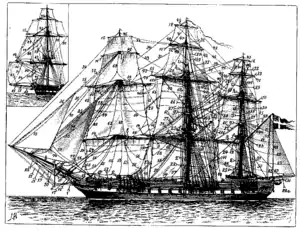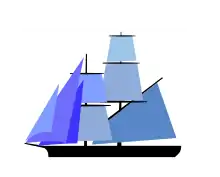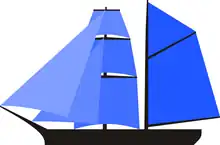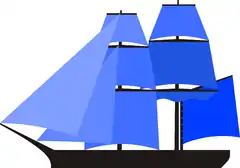
A sailing vessel's rig is its arrangement of masts, sails and rigging.[1] Examples include a schooner rig, cutter rig, junk rig, etc.[2] A rig may be broadly categorized as "fore-and-aft", "square", or a combination of both. Within the fore-and-aft category there is a variety of triangular and quadrilateral sail shapes. Spars or battens may be used to help shape a given kind of sail. Each rig may be described with a sail plan—formally, a drawing of a vessel, viewed from the side.
Modern examples of single-person sailing craft, such as windsurfers, iceboats, and land-sailing craft, typically have uncomplicated rigs with a single sail on a mast with a boom.
Introduction
In the English language, ships were usually described, until the end of the eighteenth century, in terms of their type of hull design. Using the type of rig as the main type identifier for a vessel became common only in the nineteenth century.[3]: 29 This is illustrated by the terminology for ships in the large fleet of colliers that traded to London from the coal ports of the Northeast of England (of which HMS Endeavour was a well-known example). Many of these full-rigged ships (square rigged on all of three masts) had the hull type "bark" – another common classification was "cat". In the second half of the eighteenth century, the square sails on the mizzen were often eliminated. The resulting rig acquired the name of the hull type: initially as "bark" and soon as "barque". This explains the Royal Navy's description of Endeavour as a "cat-built bark".[3]: 51, 57-61
Design
.tif.jpg.webp)
Each rig may be described with a sail plan—a drawing of a vessel, viewed from the side, depicting its sails, the spars that carry them and some of the rigging that supports the rig.[4] By extension, "sail plan" describes the arrangement of sails on a vessel.[5][6] A well-designed sail plan should be balanced, requiring only light forces on the helm to keep the sailing craft on course. The fore-and-aft center of effort on a sail plan is usually slightly behind the center of resistance of the hull,[lower-alpha 1] so that the sailing craft will tend to turn into the wind if the helm is unattended.[7] The height of the sail plan's center of effort above the surface is limited by the sailing craft's ability to avoid capsize, which is a function of its hull shape, ballast, or hull spacing (in the case of catamarans and trimarans).[8]
Types of rig
- Fore-and-aft rig features sails that run fore and aft (along the length of the sailing craft), controlled by lines called "sheets", that changes sides, as the bow passes through the wind from one side of the craft to the other. Fore-and-aft rig variants include:
- Bermuda rig (also known as a Marconi rig) features a three-sided mainsail.
- Gaff rig features a four-sided mainsail with the upper edge made fast to a spar called a gaff.[9]
- Spritsail rig features a four-sided mainsail with the aft upper corner supported by a diagonal spar, called a sprit, whose lower end meets the mast near the foot of the sail.
- Lateen rig features a three-sided sail set on a long yard, mounted at an angle on the mast and running in a fore-and-aft direction.
- Crab claw sail (also known as Oceanic sprit or Oceanic lateen) features a three-sided sail with spars on both the foot and the head. It's either mastless, supported by a "prop", or mounted on removable or fixed masts.
- Tanja sail (also known as canted square/rectangular sail, balance lugsail, or boomed lugsail) features a four-sided sail with spars on both the foot and the head. It's mounted on removable or fixed masts.
- Square rig uses square sails as the major sails on a vessel. It is common for square rigged vessels to include some fore and aft sails, such as staysails. A mast may be referred to as a square rigged mast where square sails predominate – this would differentiate from other masts on the same vessel being fore-and-aft rigged, for example in a barque.
Square sails are generally suspended from yards which, when at rest, are at right angles ("square") to the centre-line of the vessel. This differentiates them from fore-and-aft sails, which are aligned along the centre-line when at rest.[10]: 2 Operationally, this means that square sails always present the same surface of the sail to the wind when propelling a vessel forward: they have a front and a back. Fore-and-aft sails can have either of their surfaces facing the wind when in use. Hence either vertical edge of a square sail may be the front (when sailing to windward) but fore-and-aft sails always have the same vertical edge at the front.
Types of sail
Each form of rig requires its own type of sails. Among them are:
- A staysail (pronounced stays'l) is a fore-and-aft sail whose leading edge (or luff) is hanked to a stay.
- A headsail is any sail forward of the foremost mast on a sailing boat. It is usually a fore-and-aft sail, but on older sailing ships would include a square-sail on a bowsprit.[11]
- A jib is a headsail that is set in front of any other headsails, or in modern usage, may be the only headsail. It may be hanked to a stay, used in roller reefing or set flying (as in the more traditional cutter rigs).[12]: 28–29 In a large vessel with many headsails, you may, for example, find a flying jib, outer-jib, inner-jib and then the fore-staysail.[10]: 64, 94
- A genoa is a large jib that increases area by extending rearward of the mast.
- A spinnaker is a full sail of light material for use when sailing downwind in light airs. When in use, the jib or genoa would be lowered.
- A gennaker is a sail that is a cross between a genoa and a spinnaker.
- A mainsail ("mains'l") is a sail attached to the main mast. The principal types include:
- A square-rig mainsail is a square sail attached at the bottom of the main mast.
- A Bermuda-rig mainsail is a triangular sail with the luff attached to the mast with the foot or lower edge generally attached to a boom.
- A gaff-rig mainsail is a quadrilateral sail whose head is supported by a gaff.
- A spritsail-rig mainsail is a quadrilateral sail whose aft head is supported by a sprit.
- A lug sail is an asymmetric quadrilateral sail suspended on a spar and hoisted up the mast as a fore-and-aft sail.
- A mizzen sail is a small triangular or quadrilateral sail at the stern of a boat.
- A steadying sail is a mizzen sail on motor vessels such as old-fashioned drifters and navy ships (such as HMS Prince Albert). The sail's prime function is to reduce rolling rather than to provide drive.
- Quadrilateral examples
 A square sail is loose-footed, but may be attached to a spar, below.
A square sail is loose-footed, but may be attached to a spar, below.
 A lugsail has a tall asymmetrical shape.
A lugsail has a tall asymmetrical shape. A settee sail has an elongated asymmetrical shape.
A settee sail has an elongated asymmetrical shape. A gaff rigged sail has a spar above and a boom below.
A gaff rigged sail has a spar above and a boom below. A gunter rig has a vertical spar that extends vertically above the mast.
A gunter rig has a vertical spar that extends vertically above the mast.
- Triangular examples
 A bermuda rigged sail has one edge attached to the mast.
A bermuda rigged sail has one edge attached to the mast. A lateen sail is loose-footed.
A lateen sail is loose-footed. A crabclaw sail has spars along two sides.
A crabclaw sail has spars along two sides. Spinnakers are attached at their corners.
Spinnakers are attached at their corners.
European and American vessels
Ships that sailed from Europe and the Americas could be categorized in a variety of ways, by number of masts and by sailing rig.
Single-masted sailing vessels include the catboat, cutter and sloop. Two-masted vessels include the bilander, brig, brigantine, ketch, schooner, snow, and yawl. Three-masted vessels include the barque, barquentine, polacre and full-rigged ship. Luggers could have one or two masts and schooners could have two or more masts.
Square-rigged masts

A three-masted vessel has, from front to back, a foremast, mainmast and mizzenmast. A two-masted vessel has a mainmast, the other being a foremast or mizzen. Ships with more than three masts may simply number them or use another scheme, as with the five-masted Preussen.
On a square-sailed vessel, the sails of each mast are named by the mast and position on the mast. For instance, on the mainmast (from bottom to top):
- main course
- main topsail
- main topgallant ("t'gallant")
- main royal
- main skysail
- main moonraker. [lower-alpha 2]
On many ships, sails above the top (a platform just above the lowest sail on the fore, main and mizzens masts) were mounted on separate mast segments—"topmasts" or "topgallant masts"—held in wooden sockets called "trestletrees". These masts and their stays could be rigged or struck as the weather conditions required, or for maintenance and repair.[13]
In light breezes, the working square sails would be supplemented by studding sails ("stuns'l") out on the ends of the yardarms. These were called as a regular sail, with the addition of "studding". For example, the main top studding sail.[13]
Between the main mast and mizzen as well as between main mast and foremast, the staysails between the masts are named from the sail immediately below the highest attachment point of the stay holding up that staysail. Thus, the mizzen topgallant staysail can be found dangling from the stay leading from above the mizzen (third) mast's topgallant sail (i.e., from the mizzen topgallant yard) to at least one and usually two sails down from that on the main mast (the slope of the top edge of all staysail lines runs from a higher point nearer the stern to a lower point towards the bow).[13]
The jibs (the staysails between the foremast and the bowsprit) are named (from inner to outer most) fore topmast staysail (or foretop stay), inner jib, outer jib and flying jib. Many of the jibs' stays meet the foremast just above the fore topgallant. A fore royal staysail may also be set.[13]
Austronesian and Asian vessels
Austronesian
 Traditional Austronesian generalized sail types. C, D, E, and F are types of crab claw sails. G, H, and I are tanja sails.[14]
Traditional Austronesian generalized sail types. C, D, E, and F are types of crab claw sails. G, H, and I are tanja sails.[14]
A Double sprit (Sri Lanka)
B Common sprit (Philippines)
C Oceanic sprit (Tahiti)
D Oceanic sprit (Marquesas)
E Oceanic sprit (Philippines)
F Crane sprit (Marshall Islands)
G Rectangular boom lug (Maluku Islands)
H Square boom lug (Gulf of Thailand)
I Trapezial boom lug (Vietnam)
Austronesian sailing rigs, include vessels with crab-claw and tanja sails. The seafaring Austronesian peoples independently developed various sail types during the Neolithic, beginning with the crab claw sail (also misleadingly called the "oceanic lateen" or the "oceanic sprit") at around 1500 BCE. They are used throughout the range of the Austronesian Expansion, from Maritime Southeast Asia, to Micronesia, Island Melanesia, Polynesia, and Madagascar. Crab claw sails are rigged fore-and-aft and can be tilted and rotated relative to the wind. They evolved from V-shaped perpendicular square sails in which the two spars converge at the base of the hull. The simplest form of the crab claw sail (also with the widest distribution) is composed of a triangular sail supported by two light spars (sometimes erroneously called "sprits") on each side. They were originally mastless, and the entire assembly was taken down when the sails were lowered.[15]
The proa is a single-outrigger Austronesian boat with one sail. Both ends are alike, and the boat is sailed in either direction, but it has a fixed leeward side and a windward side. The boat is shunted from beam reach to beam reach to change direction, with the wind over the side, a low-force procedure. The bottom corner of the crabclaw sail is moved to the other end, which becomes the bow as the boat sets off back the way it came. The mast usually hinges, adjusting the rake or angle of the mast. The proa is a low-stress rig, which can be built with simple tools and low-tech materials, but it is extremely fast. On a beam reach, it may be the fastest simple rig.
Asian
Junk rigs were in use in China by around the 12th century.[16] Iconographic remains show that Chinese ships before the 12th century used square sails.[17]: 456–457, plate CDIII–CDVI
In its most traditional form the junk rig is carried on an unstayed mast (i.e. a mast without shrouds or stays, supported only on the step at the keelson and the partners); however, standing rigging of some kind is not uncommon. It is typical to run the halyards (lines used to raise and lower the sail) and sheets (lines used to trim the sail) to the companionway on a junk-rigged boat. This means that typical sailhandling can be performed from the relative safety of the cockpit, or even while the crew is below deck.
Junk sails are typically carried on a mast which rakes (slants) forward a few degrees from vertical. This causes the sail to swing outwards, absent wind pushing it, which makes the use of a preventer (a line to keep the sail extended) unnecessary.


 Japanese kai-sen
Japanese kai-sen
Gallery
Presented alphabetically by section:
Fore-and-aft
 Catboat: single mast and sail, usually gunter- or gaff-rigged
Catboat: single mast and sail, usually gunter- or gaff-rigged

 Felucca: one to three lateen rigged masts
Felucca: one to three lateen rigged masts Gunter: sloop with gunter rig
Gunter: sloop with gunter rig Junk: one or more junk-rigged masts
Junk: one or more junk-rigged masts Ketch: two masts with mizzen mast before the tiller
Ketch: two masts with mizzen mast before the tiller
 Proa: single mast with crab claw sail
Proa: single mast with crab claw sail Schooner: two or more fore-and-aft rigged masts, first mast no taller than the second
Schooner: two or more fore-and-aft rigged masts, first mast no taller than the second Sloop: single mast with a gaff-rigged mainsail and topsail on the mainmast
Sloop: single mast with a gaff-rigged mainsail and topsail on the mainmast Yawl: two masts with mizzen mast aft of the tiller
Yawl: two masts with mizzen mast aft of the tiller
Square
With square sails on every mast
 Brig: two square-rigged masts and headsails
Brig: two square-rigged masts and headsails Fully rigged ship: three or more (all) square-rigged masts and headsails
Fully rigged ship: three or more (all) square-rigged masts and headsails
Combination
With some masts having exclusively fore-and-aft sails
 Barque: two or more square-rigged masts and headsails with fore-and-aft rigged aftmost mast
Barque: two or more square-rigged masts and headsails with fore-and-aft rigged aftmost mast Barquentine: one square-rigged mast (fore) and two or more fore-and-aft rigged (main, mizzen, etc.) masts
Barquentine: one square-rigged mast (fore) and two or more fore-and-aft rigged (main, mizzen, etc.) masts Bilander: two masts, main mast course sail lateen rigged, all others square rigged
Bilander: two masts, main mast course sail lateen rigged, all others square rigged Schooner brig: one square-rigged foremast and one fore-and-aft rigged main mast
Schooner brig: one square-rigged foremast and one fore-and-aft rigged main mast Brigantine: one square-rigged foremast and hybrid rigged main mast
Brigantine: one square-rigged foremast and hybrid rigged main mast Polacre: one square-rigged main with headsails and two lateen rigged aft masts
Polacre: one square-rigged main with headsails and two lateen rigged aft masts Topsail schooner: two schooner-rigged masts with one or more square-rigged topsails
Topsail schooner: two schooner-rigged masts with one or more square-rigged topsails Snow: headsails, two square-rigged masts, and a third smaller 'snow-mast' with a trysail
Snow: headsails, two square-rigged masts, and a third smaller 'snow-mast' with a trysail
See also
Notes
- ↑ Note: not all sailing craft are boats; land yachts have wheels and ice yachts have runners. For the sake of clarity, this article will generally address only waterborne craft.
- ↑ Since the early nineteenth century, the topsails and topgallants are often split into a lower and an upper sail to allow them to be more easily handled. This makes the mast appear to have more "sails" than it officially has.
References
- ↑ "Rig". Merriam-Webster Dictionary. 2023. Retrieved 2023-04-15.
the distinctive shape, number, and arrangement of sails and masts of a ship or to fit out with rigging
- ↑ Kemp, Dixon (1882). A Manual of Yacht and Boat Sailing. H. Cox. p. 559.
- 1 2 MacGregor, David R (1985). Merchant Sailing Ships 1775-1815: Sovereignty of Sail. London: Conway Maritime Press. ISBN 0-85177-323-0.
- ↑ "Sail plan". Collins English Dictionary. 2023.
- ↑ Folkard, Henry Coleman (2012). Sailing Boats from Around the World: The Classic 1906 Treatise. Dover Maritime. Courier Corporation. p. 576. ISBN 9780486311340.
- ↑ Committee, Cruising Club of America Technical (1987). Desirable and Undesirable Characteristics of Offshore Yachts. W. W. Norton & Company. p. 161. ISBN 978-0-393-03311-3.
- ↑ Royce, Patrick M. (1997). Royce's Sailing Illustrated. ProStar Publications. p. 74. ISBN 978-0-911284-07-2.
- ↑ Killing, Steve; Hunter, Douglas (1998). Yacht Design Explained: A Sailor's Guide to the Principles and Practice of Design. W. W. Norton & Company. p. 153. ISBN 978-0-393-04646-5.
- ↑ Leather, John (2001-01-11). The Gaff Rig Handbook: History, Design, Techniques, Developments. WoodenBoat Books. ISBN 978-0-937822-67-8.
- 1 2 Underhill, Harold (1946) [1938]. Masting and Rigging, the Clipper Ship and Ocean Carrier (1958 reprint ed.). Glasgow: Brown, Son and Ferguson, Ltd.
- ↑ "Definition of 'headsail'". Collins. Retrieved 12 May 2019.
- ↑ Cunliffe, Tom (2016). Hand, Reef and Steer: Traditional Sailing Skills for Classic Boats (second ed.). Adlard Coles. ISBN 978-1472925220.
- 1 2 3 4 Nares, George Strong (1897). Seamanship: Including Names of Principal Parts of a Ship. Griffin & Company. pp. 106–256.
- ↑ Doran, Edwin B. (1981). Wangka: Austronesian Canoe Origins. Texas A&M University Press. ISBN 9780890961070.
- ↑ Campbell, I.C. (1995). "The Lateen Sail in World History". Journal of World History. 6 (1): 1–23. JSTOR 20078617.
- ↑ L. Pham, Charlotte Minh-Hà (2012). Asian Shipbuilding Technology. Bangkok: UNESCO Bangkok Asia and Pacific Regional Bureau for Education. pp. 20–21. ISBN 978-92-9223-413-3. Retrieved 15 February 2023.
- ↑ Needham, Joseph (1971). Science and Civilisation in China: Volume 4, Physics and Physical Technology, Part III: Civil Engineering and Nautics. Cambridge: Cambridge University Press.
Further reading
- Bolger, Philip C. (1998). 103 Sailing Rigs "Straight Talk". Gloucester, Maine: Phil Bolger & Friends, Inc. ISBN 0-9666995-0-5.
- Moore, Sir Alan Hilary; Nance, R. Morton (1925). Last days of mast & sail : An Essay in Nautical Comparative Anatomy. Clarendon Press, Oxford. OL 26571876M.